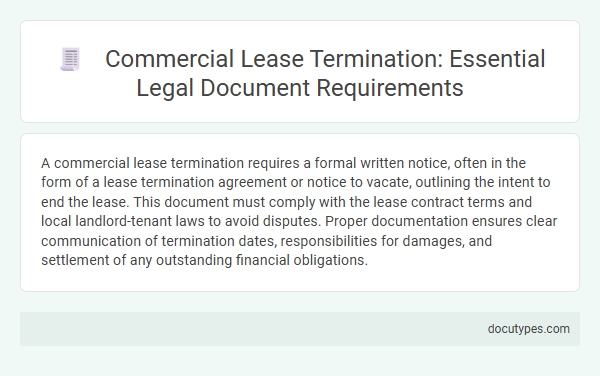A commercial lease termination requires a formal written notice, often in the form of a lease termination agreement or notice to vacate, outlining the intent to end the lease. This document must comply with the lease contract terms and local landlord-tenant laws to avoid disputes. Proper documentation ensures clear communication of termination dates, responsibilities for damages, and settlement of any outstanding financial obligations.
Introduction to Commercial Lease Termination
Commercial lease termination involves ending a rental agreement between a landlord and a business tenant before the lease term expires. This process requires specific legal documentation to ensure the termination is valid and enforceable.
The primary legal document needed is a Lease Termination Agreement, which outlines the terms agreed upon by both parties. Proper execution of this document protects the rights of landlords and tenants and helps avoid potential disputes.
Key Legal Grounds for Terminating a Commercial Lease
Terminating a commercial lease requires a formal legal document known as a lease termination agreement or notice of lease termination. This document outlines the intent to end the lease and must comply with the terms specified in the original commercial lease contract.
Key legal grounds for terminating a commercial lease include breach of contract by either party, such as non-payment of rent or failure to maintain the property. Other valid reasons involve mutual agreement, property damage making the premises unusable, or landlord's failure to provide necessary services as required by law.
Essential Legal Documents Required for Lease Termination
Terminating a commercial lease requires specific legal documents to ensure the process is valid and enforceable. Essential documents protect both landlords and tenants by clearly outlining the terms of lease termination.
The primary document is the Lease Termination Agreement, which details the conditions under which the lease ends and must be signed by both parties. Notice of Termination is also crucial and should comply with lease terms and local laws, specifying the termination date. You may also need to provide documentation related to the final inspection or settlement of outstanding payments and repairs.
Notice of Lease Termination: Legal Standards and Format
The primary legal document required for commercial lease termination is the Notice of Lease Termination. This notice must comply with specific legal standards, including clear identification of the parties, property details, and the termination date. Proper format often involves written communication delivered via certified mail or personal delivery to ensure legal validity and enforceability.
Drafting and Serving the Lease Termination Notice
Terminating a commercial lease requires a formal legal document known as a Lease Termination Notice. Proper drafting and serving of this notice ensures compliance with lease terms and applicable laws.
- Lease Termination Notice - A written document that clearly states the intent to end the commercial lease agreement on a specified date.
- Notice Requirements - The notice must comply with the lease contract terms, including timing, delivery methods, and content specifications.
- Serving the Notice - The notice should be delivered via legally recognized methods such as certified mail or personal service to ensure proof of delivery.
Supporting Documentation for Lease Termination
What legal document is required for commercial lease termination? A formal lease termination agreement is essential to outline the terms of ending the lease. Supporting documentation typically includes the original lease contract, written notice of termination, and any correspondence between landlord and tenant.
Landlord and Tenant Rights During Lease Termination
Terminating a commercial lease requires a specific legal document to ensure both landlord and tenant rights are protected. Your rights during lease termination depend on the lease agreement and local property laws.
- Notice of Lease Termination - A formal written notification specifying the intent to end the lease under agreed or statutory terms.
- Mutual Termination Agreement - A signed contract between landlord and tenant outlining agreed conditions for ending the lease early.
- Lease Agreement Review - A thorough examination of the original lease to understand termination clauses, obligations, and penalties.
Proper legal documentation safeguards your interests and ensures a smooth commercial lease termination process.
Common Pitfalls in Lease Termination Documentation
| Legal Document Required for Commercial Lease Termination | Termination Agreement or Lease Termination Notice |
|---|---|
| Definition | A legally binding document that formally ends the lease contract between landlord and tenant before the original expiration date. |
| Purpose | To specify the terms under which the lease is terminated, including effective date, financial obligations, and responsibilities of both parties. |
| Common Pitfalls in Lease Termination Documentation |
|
| Best Practices | Use clear, precise language; adhere to lease and legal notice requirements; ensure mutual consent; include all necessary terms; and consult legal counsel to comply with laws. |
Legal Compliance and Jurisdictional Requirements
Commercial lease termination requires a legally binding document, typically a lease termination agreement or notice of termination, to ensure compliance with contract terms and local laws. Jurisdictional requirements vary, so it is essential to consult relevant state or municipal regulations to meet specific notice periods and formalities. You must obtain and execute the proper documentation to avoid disputes and ensure the termination is enforceable under the applicable legal framework.
What Legal Document Is Required for Commercial Lease Termination? Infographic

